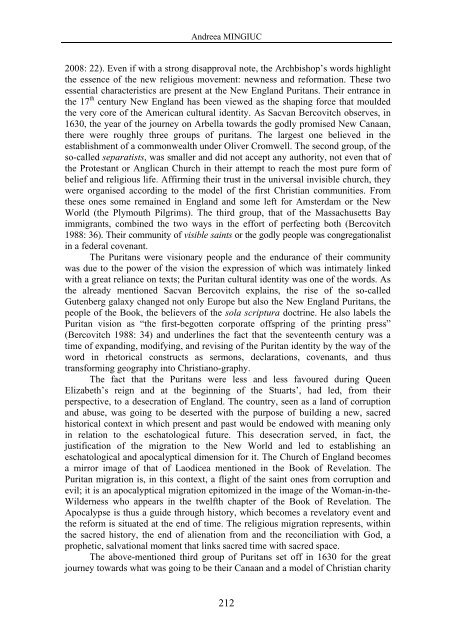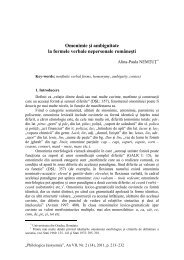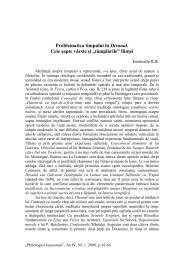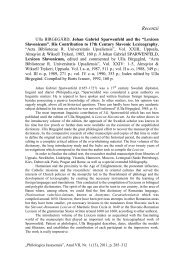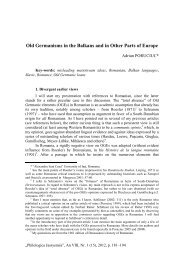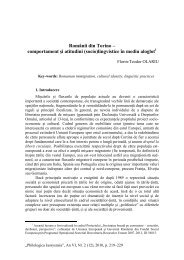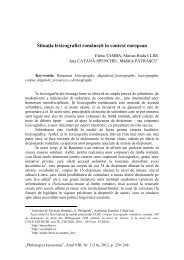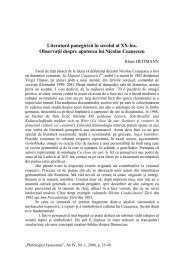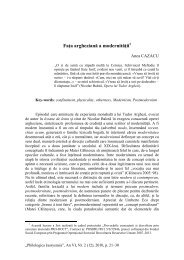Key Concepts of Puritanism and the Shaping of the American Cultural
Key Concepts of Puritanism and the Shaping of the American Cultural
Key Concepts of Puritanism and the Shaping of the American Cultural
You also want an ePaper? Increase the reach of your titles
YUMPU automatically turns print PDFs into web optimized ePapers that Google loves.
Andreea MINGIUC<br />
2008: 22). Even if with a strong disapproval note, <strong>the</strong> Archbishop’s words highlight<br />
<strong>the</strong> essence <strong>of</strong> <strong>the</strong> new religious movement: newness <strong>and</strong> reformation. These two<br />
essential characteristics are present at <strong>the</strong> New Engl<strong>and</strong> Puritans. Their entrance in<br />
<strong>the</strong> 17 th century New Engl<strong>and</strong> has been viewed as <strong>the</strong> shaping force that moulded<br />
<strong>the</strong> very core <strong>of</strong> <strong>the</strong> <strong>American</strong> cultural identity. As Sacvan Bercovitch observes, in<br />
1630, <strong>the</strong> year <strong>of</strong> <strong>the</strong> journey on Arbella towards <strong>the</strong> godly promised New Canaan,<br />
<strong>the</strong>re were roughly three groups <strong>of</strong> puritans. The largest one believed in <strong>the</strong><br />
establishment <strong>of</strong> a commonwealth under Oliver Cromwell. The second group, <strong>of</strong> <strong>the</strong><br />
so-called separatists, was smaller <strong>and</strong> did not accept any authority, not even that <strong>of</strong><br />
<strong>the</strong> Protestant or Anglican Church in <strong>the</strong>ir attempt to reach <strong>the</strong> most pure form <strong>of</strong><br />
belief <strong>and</strong> religious life. Affirming <strong>the</strong>ir trust in <strong>the</strong> universal invisible church, <strong>the</strong>y<br />
were organised according to <strong>the</strong> model <strong>of</strong> <strong>the</strong> first Christian communities. From<br />
<strong>the</strong>se ones some remained in Engl<strong>and</strong> <strong>and</strong> some left for Amsterdam or <strong>the</strong> New<br />
World (<strong>the</strong> Plymouth Pilgrims). The third group, that <strong>of</strong> <strong>the</strong> Massachusetts Bay<br />
immigrants, combined <strong>the</strong> two ways in <strong>the</strong> effort <strong>of</strong> perfecting both (Bercovitch<br />
1988: 36). Their community <strong>of</strong> visible saints or <strong>the</strong> godly people was congregationalist<br />
in a federal covenant.<br />
The Puritans were visionary people <strong>and</strong> <strong>the</strong> endurance <strong>of</strong> <strong>the</strong>ir community<br />
was due to <strong>the</strong> power <strong>of</strong> <strong>the</strong> vision <strong>the</strong> expression <strong>of</strong> which was intimately linked<br />
with a great reliance on texts; <strong>the</strong> Puritan cultural identity was one <strong>of</strong> <strong>the</strong> words. As<br />
<strong>the</strong> already mentioned Sacvan Bercovitch explains, <strong>the</strong> rise <strong>of</strong> <strong>the</strong> so-called<br />
Gutenberg galaxy changed not only Europe but also <strong>the</strong> New Engl<strong>and</strong> Puritans, <strong>the</strong><br />
people <strong>of</strong> <strong>the</strong> Book, <strong>the</strong> believers <strong>of</strong> <strong>the</strong> sola scriptura doctrine. He also labels <strong>the</strong><br />
Puritan vision as “<strong>the</strong> first-begotten corporate <strong>of</strong>fspring <strong>of</strong> <strong>the</strong> printing press”<br />
(Bercovitch 1988: 34) <strong>and</strong> underlines <strong>the</strong> fact that <strong>the</strong> seventeenth century was a<br />
time <strong>of</strong> exp<strong>and</strong>ing, modifying, <strong>and</strong> revising <strong>of</strong> <strong>the</strong> Puritan identity by <strong>the</strong> way <strong>of</strong> <strong>the</strong><br />
word in rhetorical constructs as sermons, declarations, covenants, <strong>and</strong> thus<br />
transforming geography into Christiano-graphy.<br />
The fact that <strong>the</strong> Puritans were less <strong>and</strong> less favoured during Queen<br />
Elizabeth’s reign <strong>and</strong> at <strong>the</strong> beginning <strong>of</strong> <strong>the</strong> Stuarts’, had led, from <strong>the</strong>ir<br />
perspective, to a desecration <strong>of</strong> Engl<strong>and</strong>. The country, seen as a l<strong>and</strong> <strong>of</strong> corruption<br />
<strong>and</strong> abuse, was going to be deserted with <strong>the</strong> purpose <strong>of</strong> building a new, sacred<br />
historical context in which present <strong>and</strong> past would be endowed with meaning only<br />
in relation to <strong>the</strong> eschatological future. This desecration served, in fact, <strong>the</strong><br />
justification <strong>of</strong> <strong>the</strong> migration to <strong>the</strong> New World <strong>and</strong> led to establishing an<br />
eschatological <strong>and</strong> apocalyptical dimension for it. The Church <strong>of</strong> Engl<strong>and</strong> becomes<br />
a mirror image <strong>of</strong> that <strong>of</strong> Laodicea mentioned in <strong>the</strong> Book <strong>of</strong> Revelation. The<br />
Puritan migration is, in this context, a flight <strong>of</strong> <strong>the</strong> saint ones from corruption <strong>and</strong><br />
evil; it is an apocalyptical migration epitomized in <strong>the</strong> image <strong>of</strong> <strong>the</strong> Woman-in-<strong>the</strong>-<br />
Wilderness who appears in <strong>the</strong> twelfth chapter <strong>of</strong> <strong>the</strong> Book <strong>of</strong> Revelation. The<br />
Apocalypse is thus a guide through history, which becomes a revelatory event <strong>and</strong><br />
<strong>the</strong> reform is situated at <strong>the</strong> end <strong>of</strong> time. The religious migration represents, within<br />
<strong>the</strong> sacred history, <strong>the</strong> end <strong>of</strong> alienation from <strong>and</strong> <strong>the</strong> reconciliation with God, a<br />
prophetic, salvational moment that links sacred time with sacred space.<br />
The above-mentioned third group <strong>of</strong> Puritans set <strong>of</strong>f in 1630 for <strong>the</strong> great<br />
journey towards what was going to be <strong>the</strong>ir Canaan <strong>and</strong> a model <strong>of</strong> Christian charity<br />
212


